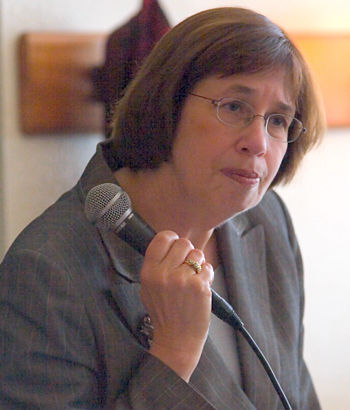Linda Greenhouse
Linda Greenhouse is a Pullitzer Prize winning legal journalist. Greenhouse who wrote for the New York Times from 1968 to early 2008.[1] Greenhouse began covering the United States Supreme Court in 1972.[2] Greenhouse has appeared as a legal expert on various televsion news shows.
Covering the Supreme Court's rulings on Guantanamo captives
Greenhouse's husband, Eugene R. Fidell, is also a lawyer -- a specialist in military law. He has been a critic of the Bush Presidency's policy on captives taken in the "war on terror".[3][4]
On January 20, 2008 Clark Hoyt, of the New York Times described Fidell holding back in participating in preparing a brief submitted to the Supreme Court on behalf of National Institute of Military Justice and the Bar Association of the District of Columbia because of the concern it would be considered a conflict of interest, due to his wife covering the case.[5]
On January 22, 2008 Slate magazine, published an article written by Emily Bazelon and Dahlia Lithwick, criticizing the New York Times for failing to show more support for their employee.[6]
According to Bazelon and Lithwick the main critic of Greenhouse covering stories where her husband Fidell has a role is M. Edward Whelan III of the National Review. They wrote:
Unable to point to any actual bias, Whelan resorts to the petulant claim that the effect of Fidell's involvement in the detainee cases "would be impossible to separate … from the broader political bias that pervades so much of Greenhouse's reporting."
Resignation
Greenhouse and the New York Times negotiated a buyout and voluntary resignation in late February 2008.[1] The New York Times had announced a plan to trim 100 staff members, and had asked staff to consider volunteering for a buyout.
References
- ↑ 1.0 1.1 John Koblin. Supreme-Court-Whisperer Linda Greenhouse Takes $300K Times Buyout, New York Observer, February 28, 2008. Retrieved on 2008-04-28.
- ↑ Linda Greenhouse: Supreme Court Correspondent, The New York Times, PBS. Retrieved on 2008-04-28.
- ↑ Eugene R. Fidell, Dwight H. Sullivan, Detlev F. Vagts. Military Commission Law, The Army Lawyer, December 2005. Retrieved on 2007-11-10.
- ↑ Carol D. Leonnig. Panel Ignored Evidence on Detainee, Washington Post, March 27 2005, p. A01. Retrieved on 2008-01-20. “"It suggests the procedure is a sham, If a case like that can get through, what it means is that the merest scintilla of evidence against someone would carry the day for the government, even if there's a mountain of evidence on the other side."”
- ↑ Clark Hoyt. Public and Private Lives, Intersecting, New York Times, January 20, 2008. Retrieved on 2008-01-18.
- ↑ Emily Bazelon, Dahlia Lithwick. Lay Off Linda: Why doesn't the New York Times stand up for Linda Greenhouse?, Slate magazine, Tuesday, January 22, 2008. Retrieved on 2008-01-25. “Whelan didn't point to any concrete problem with Greenhouse's handling of these cases. That should be easier to do than with almost any other reporter, given that Greenhouse relies primarily on court filings and oral arguments that are publicly available in their entirety, as Yale law professor Judith Resnik points out to us. Unable to point to any actual bias, Whelan resorts to the petulant claim that the effect of Fidell's involvement in the detainee cases 'would be impossible to separate … from the broader political bias that pervades so much of Greenhouse's reporting.'”
